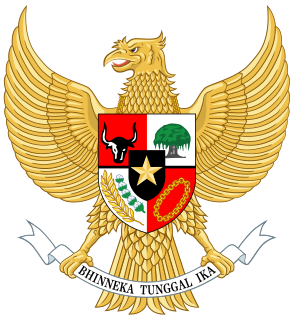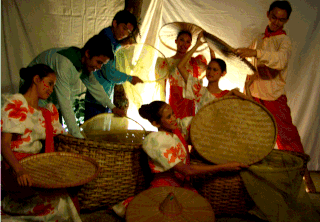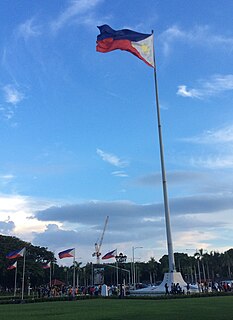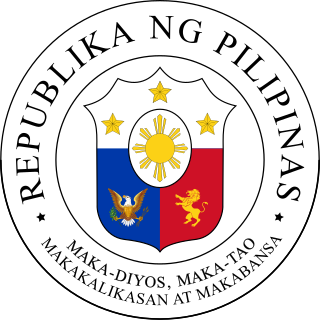
Maka-Diyos, Maka-Tao, Makakalikasan at Makabansa ("For God, People, Nature, and Country") is the national motto of the Philippines. Derived from the last four lines of the Pledge of Allegiance to the Philippine Flag, it was adopted on February 12, 1998 with the passage of Republic Act No. 8491, the Flag and Heraldic Code of the Philippines, during the presidency of Fidel V. Ramos. [1] Its adoption came twelve years after the abolition of the country's previous motto, [2] " Isang Bansa, Isang Diwa ", which was adopted during the presidency of Ferdinand Marcos in 1979.

The Philippines, officially the Republic of the Philippines, is an archipelagic country in Southeast Asia. Situated in the western Pacific Ocean, it consists of about 7,641 islands that are categorized broadly under three main geographical divisions from north to south: Luzon, Visayas, and Mindanao. The capital city of the Philippines is Manila and the most populous city is Quezon City, both part of Metro Manila. Bounded by the South China Sea on the west, the Philippine Sea on the east and the Celebes Sea on the southwest, the Philippines shares maritime borders with Taiwan to the north, Vietnam to the west, Palau to the east, and Malaysia and Indonesia to the south.

The Pledge of Allegiance to the Philippine Flag is the pledge to the flag of the Philippines. It is one of two national pledges, the other being the Patriotic Oath, which is the Philippine national pledge.

Isang Bansa, Isang Diwa was the national motto of the Philippines from 1978 to 1986, during the rule of President Ferdinand Marcos. It was adopted on June 9, 1978 by virtue of Presidential Decree No. 1413. The motto has been criticized and has been denounced as "the slogan of a fascist regime".
The motto has been interpreted as embodying a set of common core Filipino values, with each of the four being connected to one another. [3] Columnist Bobit Avila of the Philippine Star interpreted the motto as showing that Filipinos love God first before anything else. [4] Another columnist, Kay Malilong Isberto of The Freeman , the Cebu City-based sister paper of the Star, meanwhile explains that the motto represents the duties of good Filipino citizens. [5]
The Filipino value system or Filipino values refers to the set of values or the value system that a majority of the Filipino have historically held important in their lives. This Philippine values system includes their own unique assemblage of consistent ideologies, moral codes, ethical practices, etiquette and cultural and personal values that are promoted by their society. As with any society though, the values that an individual holds sacred can differ on the basis of religion, upbringing and other factors.

The Philippine Star is an English language print and digital newspaper in the Philippines and the flagship brand of the PhilStar Media Group. First published on 28 July 1986 by veteran journalists Betty Go-Belmonte, Max Soliven and Art Borjal, it is one of several Philippine newspapers founded after the 1986 People Power Revolution.
The Freeman is a daily newspaper published in Cebu, Philippines, by the Philippine Star. It was the first newspaper in Cebu, first published in May 1919. The motto of the newspaper is "The fair and fearless".
Although Maka-Diyos, Maka-Tao, Makakalikasan at Makabansa was made official in 1998, most Filipinos are unaware of it. In 2007, columnist Geronimo L. Sy wrote in the Manila Times that the Philippines didn't have a national motto (which he called a "national slogan") and that many of the societal problems plaguing the country were because of a lack of common direction that a national motto would embody, [6] despite the Flag and Heraldic Code being made law nine years earlier. Isberto would later suggest that most people probably don't know that there is a national motto to begin with, and of those who do know that there is one, they probably didn't take the time to contemplate how the motto should apply to their everyday lives. [5]

The Manila Times is the oldest extant English-language newspaper in the Philippines. It is published daily by The Manila Times Publishing Corp. with editorial and administrative offices at 2/F Sitio Grande Building, 409 A. Soriano Avenue, Intramuros, Manila.
Avila notes that while "Maka-Diyos, Maka-Tao, Makakalikasan at Makabansa" is "perfect" as a national motto, he claims that because most Filipinos only look out for themselves, they don't abide by the doctrines of their Christian faith, which makes the motto problematic in comparison to mottos like " Bhinneka Tunggal Ika ". [4] This is in sharp contrast to his 2013 criticism of "Isang Bansa, Isang Diwa", which he denounced as embodying poorly-executed Jacobinist thought. [7]

Bhinneka Tunggal Ika is the official national motto of Indonesia. The phrase is Old Javanese translated as "Unity in Diversity". It is inscribed in the Indonesian national symbol, Garuda Pancasila, and is mentioned specifically in article 36A of the Constitution of Indonesia. The name of Garuda is inspired by a mythical bird, the mount of Lord Vishnu and the Buddhist gold bird king, King Garuda.
A Jacobin was a member of the Jacobin Club, a revolutionary political movement that was the most famous political club during the French Revolution (1789–99). The club was so called because of the Dominican convent in Paris in the Rue Saint-Jacques where they originally met.
The national motto is inscribed in the Great Seal of the Philippines and the last part of the Pledge of Allegiance
| Filipino Version | English translation | Spanish translation |
|---|---|---|
|
|
|










